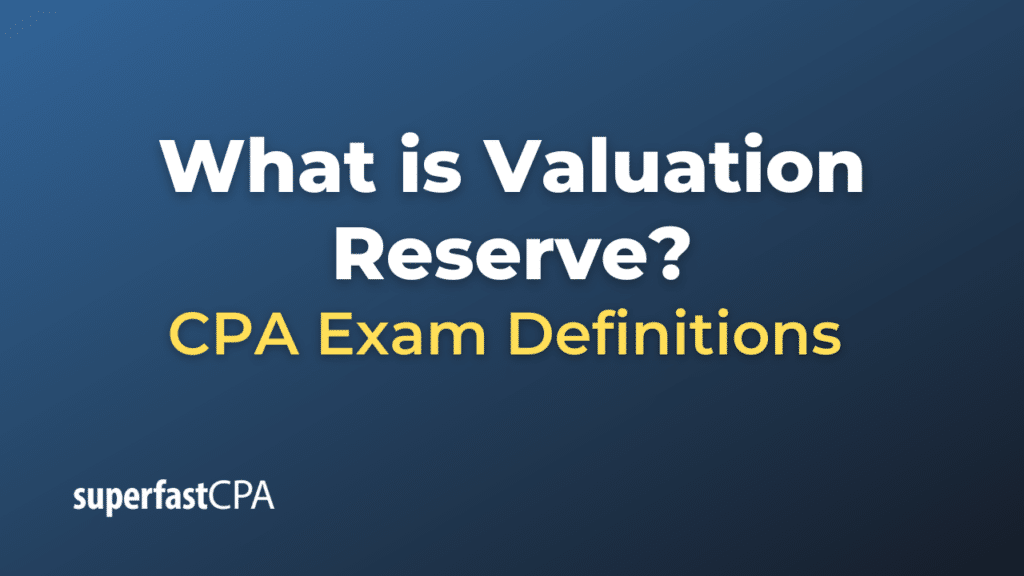Valuation Reserve
The term “Valuation Reserve” can refer to funds set aside to cover potential changes in the value of assets or liabilities. However, the terminology and its application can vary depending on the context, the industry, and the accounting framework (such as GAAP or IFRS).
Common Applications:
- Banking and Finance: Financial institutions may have valuation reserves to cover potential loan losses or changes in the value of financial instruments.
- Insurance : Insurance companies often set up reserves to cover expected future insurance claims, which could be considered a form of valuation reserve.
- Inventory: Businesses might create a valuation reserve for inventory, particularly if they have products that are likely to become obsolete, lose value over time, or are overstocked.
- Investments: A valuation reserve could be set up to offset unrealized losses on investments, acting as a cushion against adverse market conditions.
- Property Valuation: Companies with significant property holdings may establish a valuation reserve if they expect a decrease in the value of their properties, which can be due to various factors like market conditions or wear and tear.
- Deferred Tax Assets: A valuation reserve is sometimes used synonymously with a valuation allowance in the context of deferred tax assets. In this case, the reserve offsets the deferred tax asset to the extent that it is more likely than not that some portion or all of the deferred tax asset will not be realized.
Accounting Treatment:
In accounting, a valuation reserve is often treated as a contra-account that reduces the carrying value of an asset or liability to reflect a more accurate or conservative value.
- Journal Entry for Creating Valuation Reserve:
- Debit: Expense Account (e.g., Bad Debt Expense, Depreciation Expense, etc.)
- Credit: Valuation Reserve (a contra-asset or contra-liability account)
Example of Valuation Reserve
Let’s consider a fictional company, “ABC Bookstore,” which has a significant amount of inventory. The management believes that some of this inventory may become obsolete or unsellable over time. To account for this, they decide to create a valuation reserve for their inventory.
Scenario: Year-End Inventory Valuation at ABC Bookstore
ABC Bookstore has an inventory of books valued at $200,000 at year-end. Based on historical data and market conditions, the management estimates that approximately 10% of this inventory is likely to become unsellable over the next year.
Step 1: Estimating the Amount for Valuation Reserve
The company decides to set aside 10% of the total inventory value as a valuation reserve.
Valuation Reserve = $200,000 (Total Inventory Value) × 10% (Estimated Unsold Rate)
Valuation Reserve = $20,000
Step 2: Recording the Valuation Reserve
To establish the valuation reserve, ABC Bookstore will make the following journal entry:
- Journal Entry for Inventory Valuation Reserve:
- Debit: Cost of Goods Sold $20,000
- Credit: Inventory Valuation Reserve $20,000
This journal entry increases the cost of goods sold for the period, thus reducing the net income. At the same time, it creates a contra-asset account called “Inventory Valuation Reserve” that will offset the Inventory account on the balance sheet.
Step 3: Reporting on the Balance Sheet
On the balance sheet, the Inventory and its corresponding Valuation Reserve would be presented as follows:
- Inventory: $200,000
- Less: Inventory Valuation Reserve: $20,000
- Net Inventory Value: $180,000
Summary
By establishing a $20,000 valuation reserve, ABC Bookstore adheres to the accounting principle of conservatism. The reserve provides a more realistic view of the likely value of the inventory, making it clear to stakeholders that $180,000 of the $200,000 in inventory is expected to be sellable.
This use of a valuation reserve ensures that ABC Bookstore’s financial statements more accurately reflect the company’s financial condition, providing a clearer and more honest picture for investors, management, and other stakeholders.













